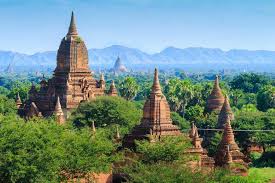Bagan, a sprawling ancient city located in Myanmar, is renowned for its awe-inspiring collection of temples and pagodas that dot its landscape. This historical treasure trove, with thousands of temples dating back to the 11th and 12th centuries, offers a unique glimpse into the grandeur of a bygone era. Whether you are a history enthusiast, an architecture aficionado, or a traveler seeking spiritual solace, Bagan has something to captivate your interest. This comprehensive guide will walk you through the majestic temples of Bagan, providing essential information for an unforgettable visit.
1. Introduction to Bagan

Historical Significance: Bagan, once the capital of the Pagan Kingdom, is one of Myanmar’s most important archaeological sites. During the height of its power, the kingdom saw the construction of over 10,000 temples and pagodas. Today, around 2,200 of these structures remain, creating a mesmerizing landscape that attracts visitors from around the world.
Cultural Importance: Bagan’s temples are not only architectural marvels but also hold immense cultural and religious significance. They serve as a testament to the artistic and spiritual achievements of the ancient Burmese civilization and continue to be an active center of Buddhist worship.
2. Top Temples to Visit
1. Ananda Temple
Overview: Often considered one of the most beautiful and well-preserved temples in Bagan, Ananda Temple is a must-visit. Built in 1091 by King Kyansittha, this temple stands out with its striking whitewashed façade and golden spires.
Highlights:
- Architectural Style: Ananda Temple features a unique blend of Mon and Indian architectural styles, characterized by its four monumental Buddha images facing each cardinal direction.
- Interior: The interior houses intricate carvings and frescoes that reflect the rich artistic traditions of the period.
2. Shwezigon Pagoda
Overview: Shwezigon Pagoda, constructed in the early 11th century, is one of the most important pilgrimage sites in Myanmar. The pagoda’s golden stupa dominates the skyline and serves as a major religious landmark.
Highlights:
- Golden Stupa: The pagoda’s shimmering gold stupa is covered in gold leaf, making it a striking sight, especially during sunrise and sunset.
- Relics: The temple houses important relics of the Buddha, making it a significant site for both locals and visitors.
3. Dhammayangyi Temple
Overview: Dhammayangyi Temple, known for its massive size and solid brickwork, is a significant structure built in the 12th century. It is the largest temple in Bagan and was commissioned by King Narathu.
Highlights:
- Architectural Features: The temple’s structure features thick walls and a vast central hall, reflecting its grandeur and the king’s ambition.
- Interior Layout: Although much of the interior has been damaged over the centuries, the temple’s layout offers insights into the grandeur of Bagan’s architectural prowess.
4. Thatbyinnyu Temple
Overview: Thatbyinnyu Temple, built in the mid-12th century, is known for its impressive height and grand architectural design. It is the tallest temple in Bagan, standing at over 60 meters.
Highlights:
- Panoramic Views: The temple’s upper terraces provide breathtaking panoramic views of the Bagan plain and its numerous temples.
- Architectural Details: The temple showcases intricate carvings and a well-preserved interior that reflects its historical significance.
5. Htilominlo Temple
Overview: Htilominlo Temple, built in the early 13th century, is renowned for its ornate plaster carvings and exquisite architectural details.
Highlights:
- Decorative Art: The temple is adorned with elaborate stucco work, depicting scenes from Buddhist Jataka tales.
- Historical Importance: It was constructed by King Htilominlo, and its design reflects the sophistication of Bagan’s later period.
3. Exploring the Temples

**1. Best Time to Visit:
a. Weather Considerations: The best time to visit Bagan is during the cooler months between November and February. The weather is more comfortable, with cooler temperatures and less humidity, making it ideal for exploring the temples.
b. Sunrise and Sunset: To experience the magic of Bagan, consider visiting the temples at sunrise or sunset. The soft light enhances the beauty of the temples and offers fantastic photo opportunities.
**2. Getting Around:
a. Bicycles and E-Bikes: Renting a bicycle or an e-bike is a popular and convenient way to explore Bagan. The flat terrain and relatively short distances between temples make biking an enjoyable option.
b. Horse Carriages: For a traditional experience, consider hiring a horse carriage. This method of transportation adds to the charm of your visit and offers a leisurely way to see the temples.
c. Private Tours: Private tours with knowledgeable guides can enhance your experience, providing historical context and insights into the significance of each temple.
**3. Respectful Behavior:
a. Dress Code: When visiting temples, it is important to dress modestly. Wear clothing that covers your shoulders and knees. Remove your shoes and socks before entering temple premises.
b. Photography: While photography is generally allowed, be respectful of local customs and follow any guidelines provided by temple authorities. Some temples may have restrictions on photography.
4. Tips for Travelers
**1. Stay Hydrated and Prepared: The climate in Bagan can be quite hot, so carry plenty of water and stay hydrated. Sunscreen, a hat, and sunglasses are essential to protect yourself from the sun.
**2. Plan Your Itinerary: With so many temples to explore, planning your itinerary in advance can help you make the most of your visit. Focus on the key temples you want to see and allocate enough time for each.
**3. Local Cuisine: Don’t miss the opportunity to sample local Myanmar cuisine. There are several restaurants and food stalls around Bagan offering traditional dishes such as mohinga (fish noodle soup) and lahpet (tea leaf salad).
**4. Respect Local Customs: Be mindful of local customs and traditions. Show respect to monks and worshippers, and always seek permission before entering areas where ceremonies or prayers are taking place.
5. Conservation and Preservation

**1. Ongoing Efforts: Efforts are continually being made to preserve and protect Bagan’s temples. Support conservation initiatives by visiting responsibly and contributing to organizations working to maintain the site’s cultural and historical heritage.
**2. Community Involvement: Engage with local communities to learn about their efforts in preserving the temples and supporting sustainable tourism practices.
Conclusion
The majestic temples of Bagan offer an unparalleled glimpse into Myanmar’s rich history and cultural heritage. Each temple, with its unique architectural style and historical significance, contributes to the grandeur of this ancient city. Whether you’re captivated by the intricate carvings of Ananda Temple, the golden splendor of Shwezigon Pagoda, or the towering presence of Thatbyinnyu Temple, Bagan’s temples promise an unforgettable experience. By exploring these architectural wonders with respect and care, you contribute to the preservation of one of the world’s most extraordinary historical sites. Enjoy your journey through Bagan and the timeless beauty of its sacred temples.



